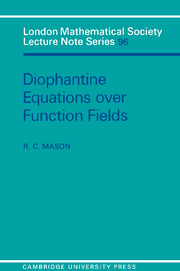Book contents
- Frontmatter
- Contents
- PREFACE
- Chapter I The Fundamental Inequality
- Chapter II The Thue Equation
- Chapter III The Hyperelliptic Equation
- Chapter IV Equations of Small Genus
- Chapter V Bounds for Equations of Small Genus
- Chapter VI Fields of Arbitrary Characteristic
- Chapter VII Solutions for Non-Zero Characteristic
- Chapter VIII The Superelliptic Equation
- References
Chapter I - The Fundamental Inequality
Published online by Cambridge University Press: 05 April 2013
- Frontmatter
- Contents
- PREFACE
- Chapter I The Fundamental Inequality
- Chapter II The Thue Equation
- Chapter III The Hyperelliptic Equation
- Chapter IV Equations of Small Genus
- Chapter V Bounds for Equations of Small Genus
- Chapter VI Fields of Arbitrary Characteristic
- Chapter VII Solutions for Non-Zero Characteristic
- Chapter VIII The Superelliptic Equation
- References
Summary
INTRODUCTION
This book demonstrates the applications of a fundamental inequality to the resolution of various general families of equations over function fields. The families concerned are the analogues of certain classical equations over number fields, and therefore we shall commence by discussing the researches of Thue, Mordell, Siegel and Baker on the theory of Diophantine equations. This discussion will be followed by an exposition of the problems surrounding the function field analogues, and an analysis of the contribution made towards this latter subject, principally by Osgood and Schmidt. The introduction will conclude with a summary of the results to be established herein, as consequences of the fundamental inequality.
The techniques of Diophantine approximation have long been applied to the study of general families of Diophantine equations. In his celebrated paper [42] of 1909, the Norwegian mathematician Thue employed approximation methods to prove that the equation f(x,y) = 1 has only finitely many solutions in integers x and y; here f denotes any irreducible binary form with rational coefficients and with degree at least three. The connexion between Thue equations, Diophantine approximation and transcendence will be discussed further in Chapter VI. The Johnian Mordell, in his Smith's prize essay of 1913 [25], demonstrated that for certain values of the non-zero integer m, the equation y2 = x3 + m has only finitely many integer solutions. Actually Mordell then conjectured that for certain other values of m there exist infinitely many integer solutions, but this was confounded by his own result [27] that the elliptic equation y2 = g(x) has only finitely many solutions in integers x, y, where g denotes a cubic polynomial with integer coefficients which contains no squared linear factor.
- Type
- Chapter
- Information
- Diophantine Equations over Function Fields , pp. 1 - 16Publisher: Cambridge University PressPrint publication year: 1984

